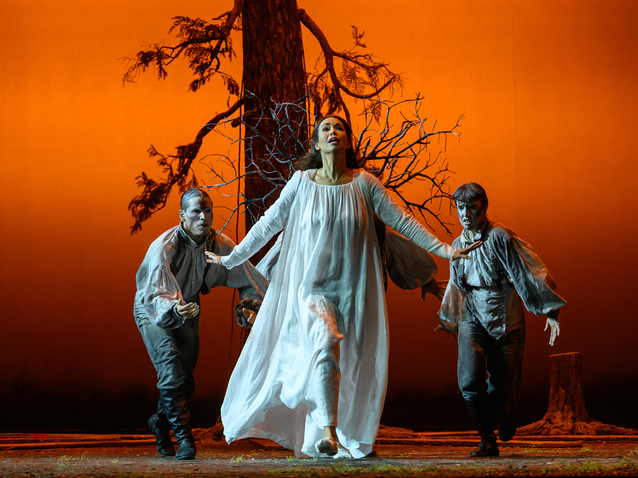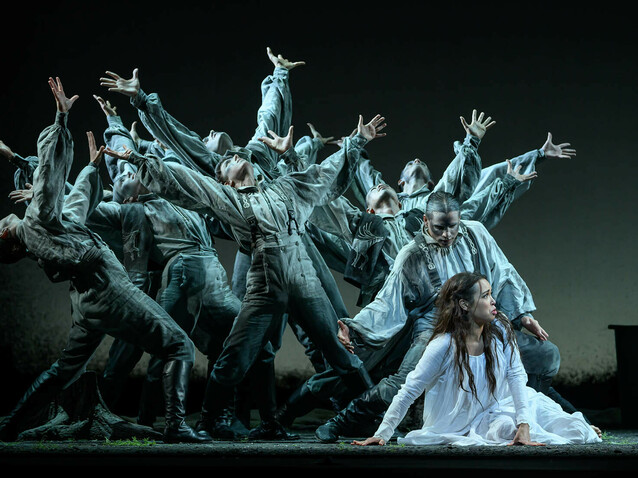 © A. Bofill / Gran Teatre del Liceu
© A. Bofill / Gran Teatre del Liceu
The success that Nadine Sierra achieved last January with La Traviata was already enormous, but what she has achieved now with La Sonnambula is even greater and consecrates her as the new undisputed queen of the Liceu.
Sierra has it all: her voice is beautiful, warm and lyrical in the centre, brilliant and sharp at the top, her breath control is exceptional, and her projection is optimal. She has an easy stratospheric treble, regulates the dynamics exquisitely in any area of the register and has an agile diaphragm that gives her ease for coloratura and for spectacularly resolving complex and risky abbellimenti.
To all this vocal excellence she adds an imposing stage presence and a natural fluency of gesture which allow her to endow her characters with intense theatrical life.
Not yet having crossed the border of the forties, Nadine Sierra is in the sweet moment of a splendid career. The Liceu, which, as a good Mediterranean theatre, is above all a “voice-worshipping” theatre, has found its diva.
Just one step below Sierra was Xabier Anduaga. The Basque tenor has a spectacular voice with a clean, bright and confident treble that allows him to tackle a very wide repertoire in the light-lyric range. His Elvino was memorable and the duets with Sierra, anthological. Anduaga could polish the bel canto style even more by regulating the dynamics a little further and letting the melody drive the singing, but without a doubt this prodigious tenor, who is not yet thirty years old, is at the beginning of a memorable career. In La Sonnambula, the Sierra-Anduaga pairing seems unbeatable today.
Conde Rodolfo is a very rewarding role that does not present too many difficulties and instead offers the interpreter a beautiful aria, “Vi ravviso, o luoghi ameni”. Fernando Radó did not take advantage of the opportunities that the score offered him, and his performance was sufficient but without depth. The Cuban Sabrina Gárdez, debuting at the theatre, did take advantage of her opportunities in the role of Lisa. Carmen Artaza was good in the role of Teresa and a little more vocal presence would have been necessary in the role of Alessio sung by Isaac Galán.
The chorus, which began somewhat unfocused, ended up offering a good performance in an opera that offers an important participation at a reasonable level of demand.

La Sonnambula, Gran Teatre del Liceu © A. Bofill
Many years ago, Richard Bonynge, Joan Sutherland's devoted conductor (and husband), made it clear that the best bel canto conductors (of which he was one) are those who do not stand out. The late bel canto by Bellini and Donizetti is pure voice, it is voice in love with its own beauty, it is a civilised and harmless form of narcissism; the orchestra must always be, humble, in the background and at the service of the voice. Lorenzo Passerini, making his debut at the Liceu, made Bonynge's mastery his own and, without dismissing the nuances and the beautiful colour details in the woodwinds, cradled the voices with delicacy. Other titles will come along that will allow him to play a greater role. The orchestra sounded sweet, which is exactly how we wanted it to sound.
La sonnambula was presented in a co-production of the Liceu with the Teatro Real de Madrid, which already presented it in the 22-23 season, the New National Theatre of Tokyo, which offered it in October 2023 and the Teatro Massimo di Palermo, which will present it next October.
The stage director of this production was Bárbara Lluch, the scenography is by Christof Daniel Hetzer and the costumes by Clara Peluffo Valentini. The scenography, which is not very attractive visually, wants to be significant and offers us a sawmill which appears to have downed all the trees of the forest except one. It is in this pre-industrial desolation that the action takes place. In some moments this works and in others – in the inn scene, for example – it is a shipwreck. Lluch's proposal contains interesting elements, the best of all being an ensemble of ten dancers who embody the dreams, nightmares, fears, desires and doubts of the sleepwalker Amina. This resource works well in the first four or five instances, after that it becomes tiresome.
The production has an important ideological bias. As stated in the handbill this production wants to “de-romanticize” the original narrative. It doesn't seem like a great idea to de-romanticize a romantic opera because there is a risk that in the end there might be nothing left.
Lluch's vindictive proposal, which more or less works overall, could not accept the ‘happy ending’ with added wedding proposed by the original music and text and daringly turned it upside down with a scenic last minute nonsense that came out of nowhere and bordered on the ridiculous, but which was very modern indeed.
Xavier Pujol
Barcelona, 5th may 2025
La sonnambula by Vincenzo Bellini. Nadine Sierra, soprano, Xabier Anduaga, tenor. Fernando Radó, baritone. Sabrina Gárdez, soprano. Carmen Artaza, mezzosoprano. Isaac Galán, baritone. Gerardo López, tenor. Orchestra of Gran Teatre del Liceu. Choir of Gran Teatre del Liceu. Lorenzo Passerini, conductor. Bárbara Lluch, stage director. Metamorphosis danza (Iratxe Ansa, Igor Bacovich), choreography. Christof Daniel Hetzer, scenography. Clara Peluffo Valentini, costumes. Urs Schönebaum, lighting. Production by Gran Teatre del Liceu, Teatro Real (Madrid), New National Theatre (Tokio) and Teatro Massimo di Palermo.
the 07 of May, 2025 | Print
Comments